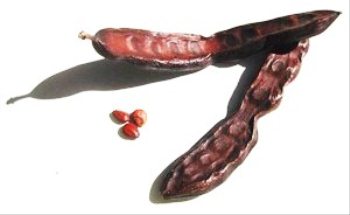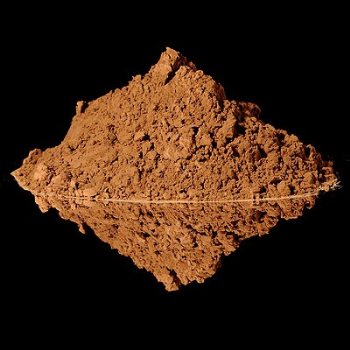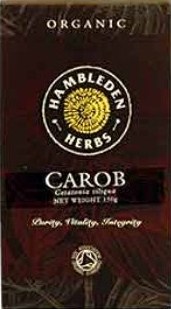The Carob Tree

|
The Carob Tree
The carob tree Ceratonia siliqua, is a species of flowering evergreen shrub or tree in the pea family, Fabaceae, that is native to the Mediterranean region, as well as Iran and the Middle-East, Portugal and probably the Canary islands. It is cultivated for its edible seed pods. Carobs are also known as St. John's bread because, according to tradition of some Christians, St. John the Baptist subsisted on them in the wilderness. A similar legend exists of Rabbi Shimon bar Yochai and his son.
 Morphology: This tree grows up to thirty three feet tall. The crown is broad and semi-spherical, supported by a thick trunk with brown rough bark and sturdy branches. Leaves are four to eight inches long, alternate, pinnate, and may or may not have a terminal leaflet. It is frost-tolerant. Most carob trees are dioecious. The trees blossom in autumn (September-October). The flowers are small and numerous, spirally arranged along the inflorescence axis in catkin-like racemes borne on spurs from old wood and even on the trunk (cauliflory); they are pollinated by both wind and insects. Male flowers produce a characteristic odour, resembling semen. The fruit is a pod that can be elongated, compressed, straight or curved, and thickened at the sutures. The pods take a full year to develop and ripen. The ripe pods eventually fall to the ground and are eaten by various mammals, thereby dispersing the seed. Likewise, carob consumed by humans is actually the dried (and sometimes roasted) pod, and not the 'nuts' or seeds.
  Habitat and Ecology: The carob genus, Ceratonia, belongs to the Fabaceae (legume) family, and is believed to be an archaic remnant of a part of this family now generally considered extinct. It grows well in warm temperate and subtropical areas, and tolerates hot and humid coastal areas. As a xerophytic (drought-resistant) species, carob is well adapted to the ecological conditions of the Mediterranean region. Trees prefer well drained loam and are intolerant of waterlogging, but the deep root systems can adapt to a wide variety of soil conditions and are fairly salt-tolerant. While previously not believed to form nitrogen fixation nodules typical of the legume family, trees have been identified more recently with nodules containing bacteria believed to be from the Rhizobium genus. Although used extensively for agriculture, carob can still be found growing wild in eastern Mediterranean regions, and has become naturalized in the west. The carob tree is typical in the southern Portuguese region of the Algarve, where it has the name alfarrobeira (for the tree), and alfarroba (for the fruit), as well as in southern Spain (Spanish: algarrobo, algarroba), Catalonia and Valencia (Catalan: garrofer, garrofa), Malta, on the Italian islands of Sicily and Sardinia (Italian: carrubo, carruba), and in Southern Greece, Cyprus as well as many Greek islands such as Crete and Samos. The common Greek name is charoupia. In Turkey, it is known as "keçiboynuzu", meaning "goat's horn". The various trees known as algarrobo in Latin America (Albizia saman in Cuba and four species of Prosopis in Argentina and Paraguay) belong to a different subfamily, Mimosoideae.
 History: Ceratonia siliqua, the scientific name of the carob tree, derives from the Greek kerátiοn (κεράτιον), “fruit of the carob” (from keras [κέρας] "horn"), and Latin siliqua "pod, carob." The term "carat", the unit by which diamond weight is measured, is also derived from the Greek word kerátiοn (κεράτιον), alluding to an ancient practice of weighing gold and gemstones against the seeds of the carob tree by people in the Middle East. The system was eventually standardized, and one carat was fixed at 0.2 grams. In late Roman times, the pure gold coin known as the solidus weighed twenty four carat seeds (about 4.5 grams). As a result, the carat also became a measure of purity for gold. Thus 24-carat gold means 100% pure, 12-carat gold means the alloy contains 50% gold, etc. Subsistence on carob pods is mentioned in the Talmud: Berakhot reports that Rabbi Haninah subsisted on carob pods. It is probably also mentioned in the New Testament, in which Matthew 3:4 reports that John the Baptist subsisted on "locusts and wild honey"; the Greek word translated "locusts" may refer to carob pods, rather than to grasshoppers. Again, in Luke 15:16, when the Prodigal Son is in the field in spiritual and social poverty, he desires to eat the pods that he is feeding to the swine because he is suffering from starvation. The use of the carob during a famine is likely a result of the carob tree's resilience to the harsh climate and drought. During a famine, the swine were given carob pods so that they would not be a burden on the farmer's limited resources. During the Second World War, it was common for the people of Malta to eat dried carob pods and prickly pears as a supplement to rationed food. This had been also common during past famines and wars.
 Traditional uses: Carob was eaten in Ancient Egypt. It was also a common sweetener and was used in the hieroglyph for "sweet" (nedjem). Dried carob fruit is traditionally eaten on the Jewish holiday of Tu Bishvat. Carob juice drinks are traditionally drunk during the Islamic month of Ramadan. Also it is believed to be an aphrodisiac. On the islands of Malta and Gozo a syrup is made out of carob pods. This is a traditional medicine for coughs and sore throat. A traditional sweet, eaten during Lent and Good Friday, is also made from carob pods in Malta. However, carob pods were mainly used as animal fodder in the Maltese Islands, apart from times of famine or war when they formed part of the diet of many Maltese. In the Iberian Peninsula carob pods were used mainly as animal fodder, especially to feed donkeys. Carob pods were an important source of sugar before sugarcane and sugar beets became widely available.
  Modern uses: Carob, dried or roasted and having a slightly sweet taste, in powder or chip form, is used as an ingredient in cakes and cookies. Carob is sometimes used as a substitute for chocolate. The seeds, also known as locust beans, are used as animal feed. They are also the source of locust bean gum, a thickening agent used in numerous processed foods. In Egypt, carobs are consumed as a snack. Crushed pods are used to make a refreshing drink. Compotes and liqueurs are made from carob in Turkey, Malta, Portugal, Spain and Sicily. Carob has proven effective in relieving diarrhea in infants. In Libya, a syrup extracted from carob named rub is used as a complement to an Asida meal. The so-called carob syrup made in Peru is actually from the fruit of the Prosopis nigra tree. Carob has also been used as a non-toxic alternative to chocolate in dog treats, as the theobromine in chocolate is fatally toxic to all animals, even humans in high enough doses (in raw form).

ALL IN ALL A REALLY USEFUL
TREE |
